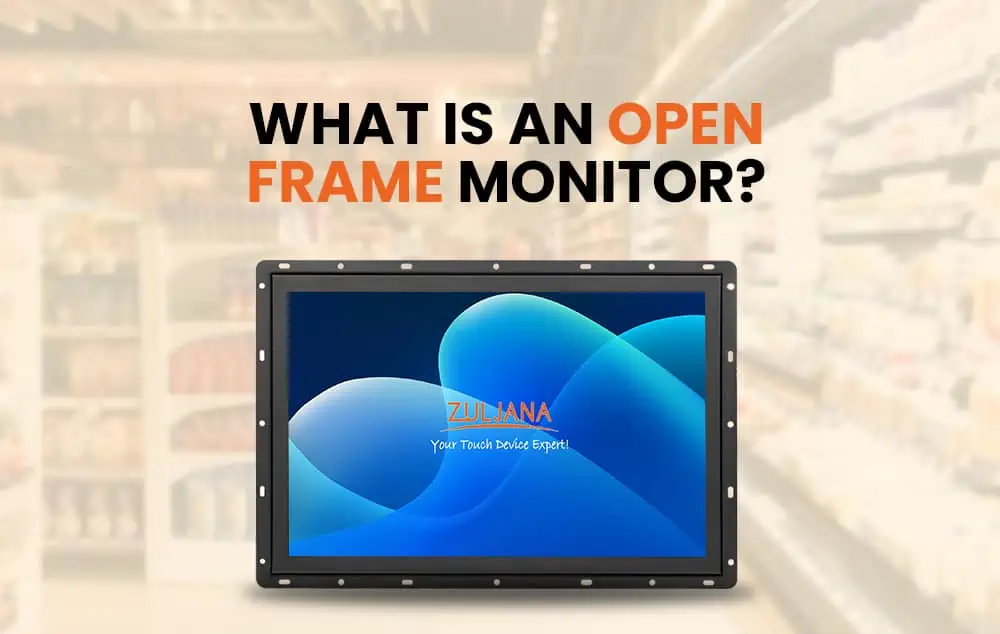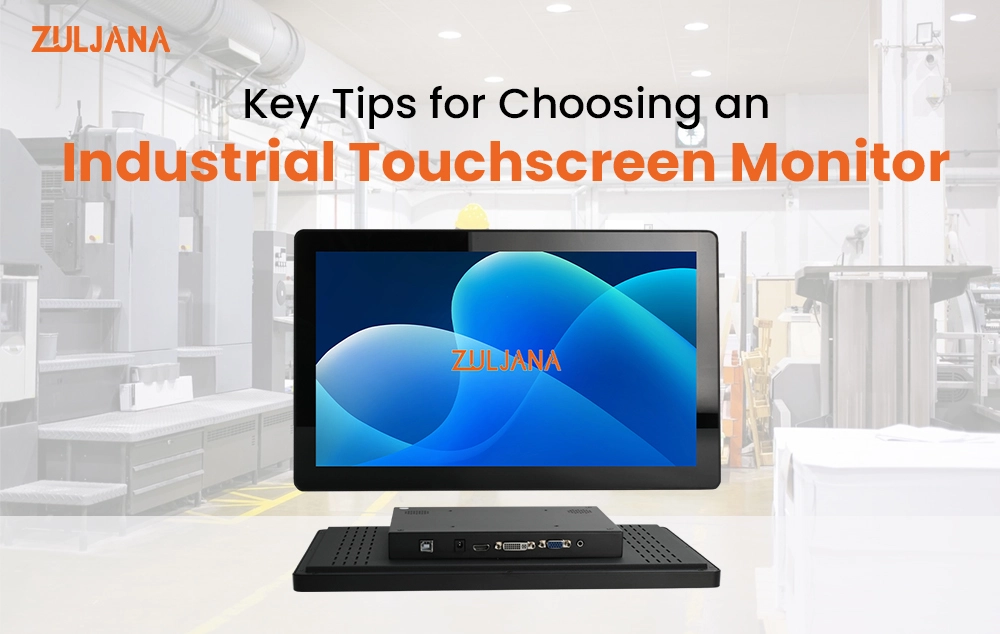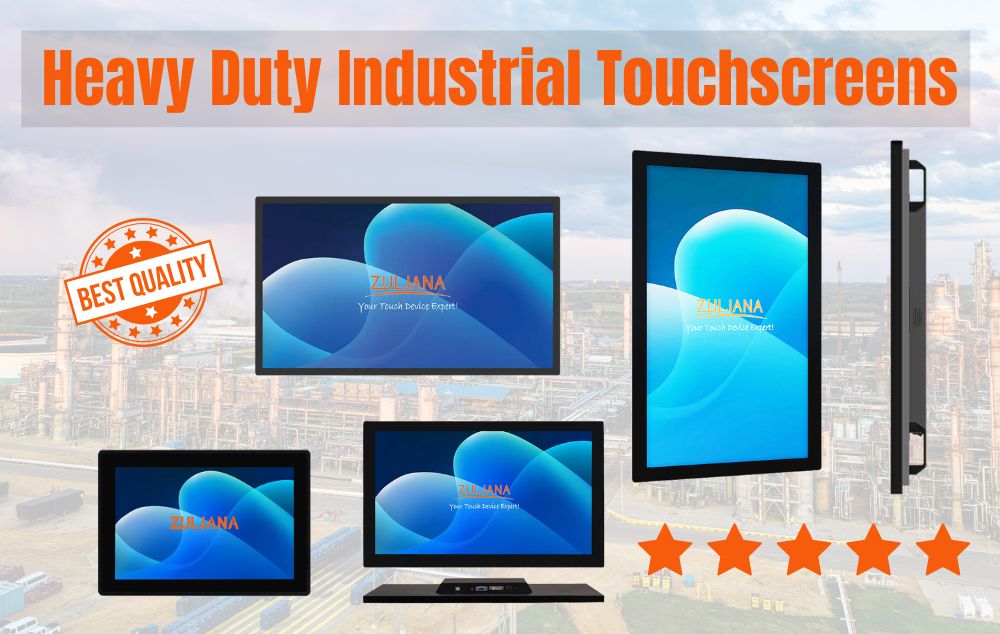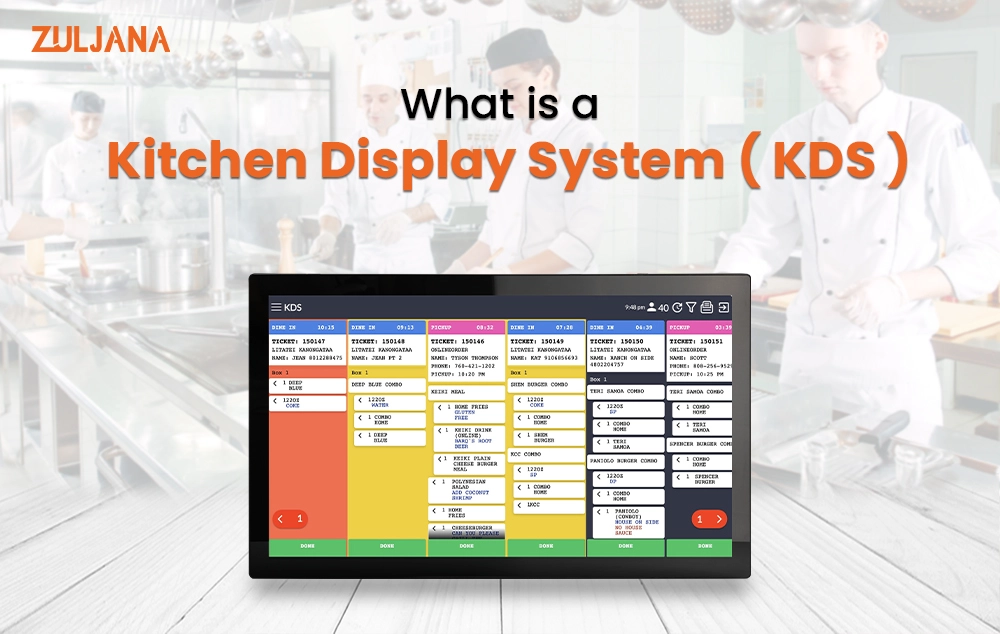An open-frame touch monitor is a computer screen primarily utilized in industrial and commercial settings. But here is an interesting thing that makes it unique, as its name (open-frame): this screen doesn’t have a frame or case around it. It can be easily adjustable into a custom frame or machine, like a kiosk or arcade game. ZULJANA also manufactures heavy-duty industrial touchscreens.

How Does Open Frame Touch Screen Monitor Work?
Open-frame monitors are used in machines such as ATMs, kiosks, and other devices where the screen is integrated into a larger system. Unlike regular monitors with a plastic case, monitor open frame has no cover. This makes it easier to fit into custom machines.
Here’s how it works:
1. Display: The main part of an open-frame monitor is the screen, which shows the images or videos. It can be an LCD (Liquid Crystal Display) or LED (Light Emitting Diode) screen.
2. Touch Capability: Some open-frame monitors have a touchscreen, so you can use your finger to select options, like on a tablet or smartphone.
3. Control Board: Behind the screen, a small board controls the images, colors, and brightness. This board connects to the computer or device inside the machine.
4. Mounting: Since these monitors have no cover, you can attach them inside a machine or stand with brackets or screws.
5. Connections: Wires from the monitor connect it to the computer inside the machine, allowing the monitor to show what the computer processes.
People choose open-frame monitors because they’re flexible, easy to install, and valuable for machines where you don’t need a fancy outer case. We have also explained resistive touchscreens.
Common Uses for Open Frame Monitors in Europe
In Europe, various industries widely use open-frame touchscreen monitors, and here are some examples:
- Information Kiosks: Open-frame monitors are used in museums, airports, and shopping malls. Visitors can touch the screen for information, such as directions or other helpful details.
- Digital Signage: Businesses and event organizers use these monitors to show ads or essential messages. You may see them in stores, events, or public areas, where they catch your attention with bright displays.
- Industry Use: Open-frame monitors are strong and easy to fit into machines. They help workers by showing meaningful information and controls, making equipment management easier.
- Self-Service Stations: Fast-food restaurants and coffee shops use these monitors at self-service stations. Customers can order and pay by touching the screen, making it faster and simpler.
- Arcade Games: Arcade game machines use open-frame monitors. These monitors show the game’s images and let you play by touching the screen.
- Custom Machines: People who build their gadgets use open-frame monitors because they fit nicely into custom designs.
After learning about the everyday use of open-frame touchscreen monitors, let’s check out their advantages and disadvantages.
Advantages of Open Frame Monitors
- Custom Fit: Open-frame touch screens are made without a case, making them easier to install in custom machines like ATMs, arcade games, and vending machines.
- Space-Saving: These monitors save space because they don’t have big plastic covers. This is helpful when fitting a computer, printer, or other equipment into small spaces.
- Flexible Design: The open-frame monitors’ design is flexible, so you can add a custom frame or style to match your machine’s look.
- Durable for Special Uses: Open-frame monitors are strong and can be used in places where regular monitors wouldn’t last long. They are used in factories, outdoor kiosks, and public transportation systems, where they can be placed in protective covers to make them more durable.
- Touchscreen Options: Many open-frame monitors have touchscreen features. These allow users to touch the screen to interact, making them perfect for kiosks, ticket machines, and other devices that need user interaction. Our tech experts also explain Panel PC applications.
Open Frame Monitor vs. Traditional Monitors
Design:
- Open-frame monitors don’t have a plastic case or stand. Designers build them to install inside machines, like ATMs or arcade games.
- Traditional Monitors, like those used with a computer at home, come with a plastic case and stand and are ready to use right out of the box.
Customization:
- Open Frame Monitors are flexible. You can fit them into custom machines and build your frame around them.
- Traditional Monitors are fully designed and ready to use, but you can’t change their look or how they’re built.
Durability:
- Open-frame monitors are designed to withstand harsher environments, such as factories or outdoor kiosks when placed inside a custom case.
- Traditional Monitors are more delicate and meant for indoor use in offices, homes, or schools.
Installation:
- Open Frame Monitors require more work to install since you need to attach them to a machine or structure.
- Traditional Monitors are simple to set up. Just plug them in, and they’re ready to go.
Uses:
- Open Frame Monitors are great for machines that need a screen but don’t need a fancy look, like ticket machines or information kiosks.
- Traditional Monitors are perfect for everyday tasks, like playing games, watching videos, or working on a computer.
In short, open frame monitors are for custom setups where you need flexibility, while traditional monitors are for easy, plug-and-play use. You can also read about what stretched bar LCD is.
FAQs
Open-frame monitors have several benefits. They fit easily into machines, save space, and can be customized to suit your needs. They are also strong and work well in tough places like factories or outdoor kiosks. Many monitors have touchscreen features, making them great for self-service stations and interactive devices.
Open-frame monitors are different from traditional monitors, mainly in their design and installation. They don’t have a built-in plastic case or stand, which allows them to be placed inside custom machines like ATMs or arcade games. Traditional monitors come with a stand and casing, making them ready to use at home or in an office. Open-frame monitors are more flexible for custom setups but need extra work to install.
Open-frame monitors are used in places like information kiosks, self-service stations, arcade games, and machines in factories. They are also found in digital signs, ticket machines, and custom devices. These monitors fit easily into different machines, making them perfect for many business and industrial uses.
Conclusion:
To wrap it up, an open-frame monitor serves as a special screen for machines like ATMs and arcade games. It doesn’t have a case around it, which makes it easy to fit into different machines and helps workers see important information. Now you know that when people ask, “What is an open-frame monitor?” It’s a flexible and helpful screen for all sorts of cool gadgets and machines.









